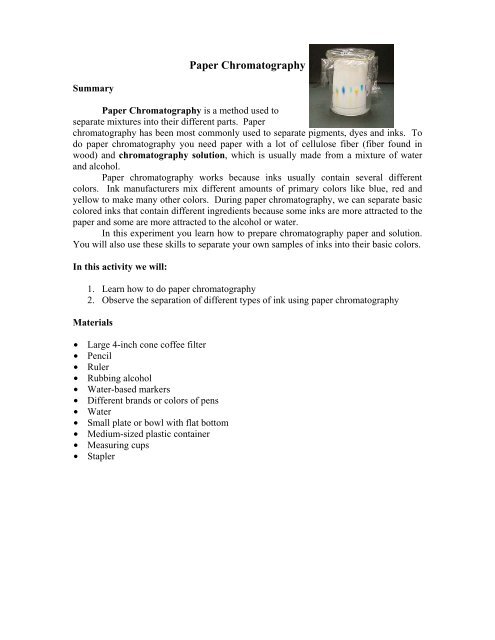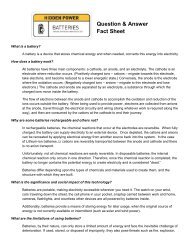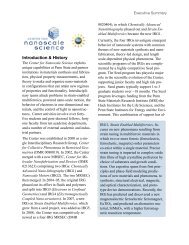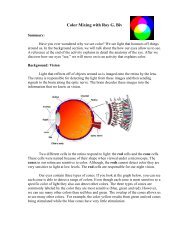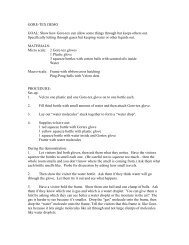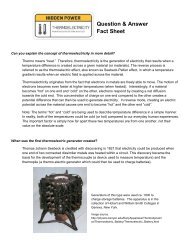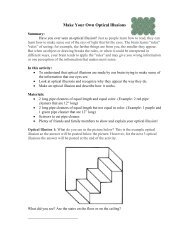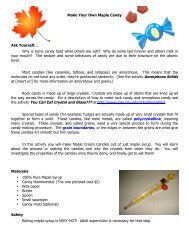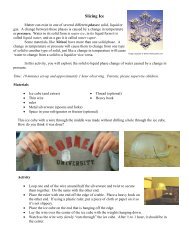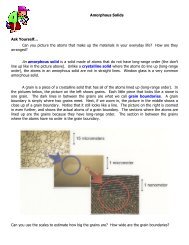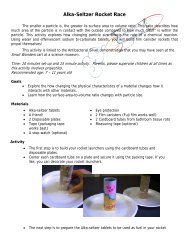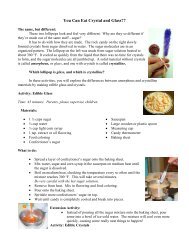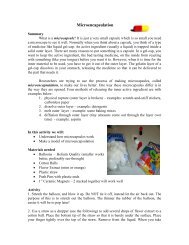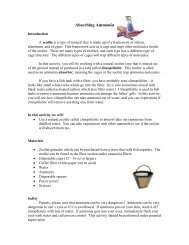Paper Chromatography
Paper Chromatography
Paper Chromatography
Create successful ePaper yourself
Turn your PDF publications into a flip-book with our unique Google optimized e-Paper software.
<strong>Paper</strong> <strong>Chromatography</strong><br />
Summary<br />
<strong>Paper</strong> <strong>Chromatography</strong> is a method used to<br />
separate mixtures into their different parts. <strong>Paper</strong><br />
chromatography has been most commonly used to separate pigments, dyes and inks. To<br />
do paper chromatography you need paper with a lot of cellulose fiber (fiber found in<br />
wood) and chromatography solution, which is usually made from a mixture of water<br />
and alcohol.<br />
<strong>Paper</strong> chromatography works because inks usually contain several different<br />
colors. Ink manufacturers mix different amounts of primary colors like blue, red and<br />
yellow to make many other colors. During paper chromatography, we can separate basic<br />
colored inks that contain different ingredients because some inks are more attracted to the<br />
paper and some are more attracted to the alcohol or water.<br />
In this experiment you learn how to prepare chromatography paper and solution.<br />
You will also use these skills to separate your own samples of inks into their basic colors.<br />
In this activity we will:<br />
1. Learn how to do paper chromatography<br />
2. Observe the separation of different types of ink using paper chromatography<br />
Materials<br />
• Large 4-inch cone coffee filter<br />
• Pencil<br />
• Ruler<br />
• Rubbing alcohol<br />
• Water-based markers<br />
• Different brands or colors of pens<br />
• Water<br />
• Small plate or bowl with flat bottom<br />
• Medium-sized plastic container<br />
• Measuring cups<br />
• Stapler
Preparation<br />
1. Cut the seam of the large 4-inch cone coffee filter so that it opens up into a fan<br />
shape. Cut out a rectangular piece that is 8 x 15 cm in size.<br />
2. Position the filter paper so that it is longer going across (see picture below).<br />
3. Draw a line using a pencil across the filter paper that is 1 cm from the top of the<br />
sheet and 1 cm from the bottom of the sheet. On the bottom line mark small lines<br />
every 2 cm and number each small line. Do not use pen for this step! You have<br />
now prepared your chromatography paper.
4. In your plastic container, mix 1/2 cup of rubbing alcohol with 1/4 cup of water.<br />
Pour carefully into the shallow plate or bowl. The height of the liquid should be<br />
no more that 1 cm. This will be your chromatography solution. Wash and dry<br />
the container for the next part of the activity.<br />
Pre-Activity<br />
1. Look at the pens and markers you want to use in this activity. Before beginning<br />
the activity, think about the following questions -<br />
a. What colors are the pens and markers?<br />
b. How do you think the manufacturers make these different colors? Do they<br />
have to use more than one color of ink?<br />
c. Do you think each pen or marker will give the same separation results on<br />
the chromatography paper? Why or why not?<br />
Activity<br />
1. On each small line of your chromatography paper, make tiny dots with your<br />
markers and your pens. Mark one pen or marker on each line. Make a key of<br />
which pen or marker goes with each number on a separate piece of paper.<br />
2. Staple the ends of your paper so that they do not touch each other.
3. Carefully place the paper onto the plate or bowl so that the marker/pen dots are<br />
just above the chromatography solution. Place a dry plastic container over the<br />
paper. Make sure that the paper does not touch the sides of the container.<br />
4. Allow the paper to sit in the solution until the liquid reaches the top line. Do not<br />
move or shake the set-up during this time. This may take about 1/2 an hour.<br />
Remove the paper and allow it to dry on a paper towel.<br />
5. Observe the results. What do you see? What happened to the different markers?<br />
Extension Activity
Mystery Ink Analysis<br />
This experiment is based on techniques used in crime labs to investigate ink<br />
samples found at crime scenes. You will need to learn basic chromatography techniques<br />
from the activity above before you can try this activity.<br />
1. Gather 4 – 5 different brands of black or blue pens. Have a friend choose one of<br />
the pens and write you a message while you are not looking.<br />
2. Now you can use chromatography to guess which pen your friend used. Carefully<br />
cut out a piece of their message and dissolve the ink off of the paper using ½ a<br />
teaspoon of rubbing alcohol.<br />
3. While the ink is dissolving, prepare a piece of chromatography paper like you did<br />
in the paper chromatography activity.<br />
4. You will also need to prepare some chromatography solution or you can re-use<br />
solution from a previous experiment.<br />
5. Take your sample pens and make small marks on the lines of the chromatography<br />
paper. Make a key of which pen goes with each number on a separate piece of<br />
paper. On the last line, make a mark of the dissolved ink from your friend’s<br />
message.<br />
6. Place your chromatography paper into the solution and allow the solution to reach<br />
the top line.<br />
7. Compare all of your samples to your friend’s sample. Can you guess which pen<br />
your friend used to write his or her note? (Hint: Try to match the separated dots<br />
(height and color) in the column from your friend’s sample to the pen samples.)<br />
Wrap Up<br />
<strong>Paper</strong> chromatography is just one of the methods that scientists can use to<br />
separate different mixtures. However, it is the only one that depends on the interactions<br />
between paper and ink to make it work. Since its discovery, paper chromatography has<br />
been used for many things. For instance, it has been used to identify the components of<br />
different inks, to separate plant pigments and it has even been used to help solve crimes!<br />
Resources<br />
www.teachersfirst.com/lessons/forensics/ink-lab.html<br />
www.reachoutmichigan.org/funexperiments/quick/csustan/mrsketch.htm


